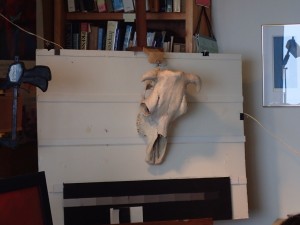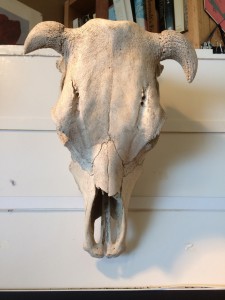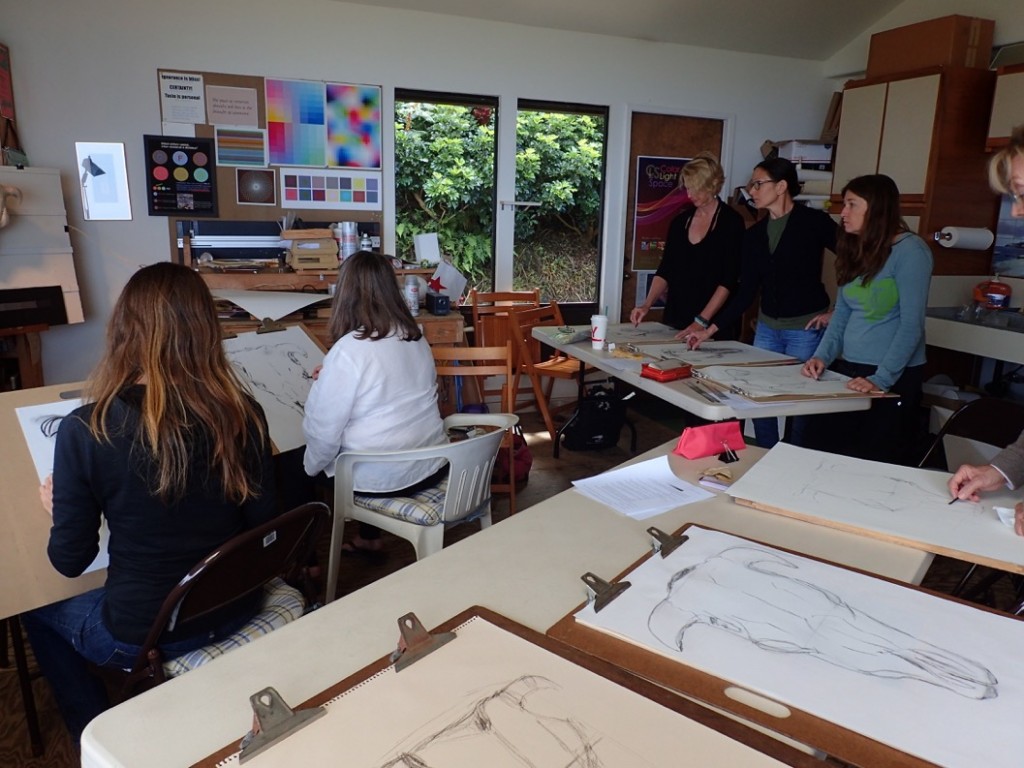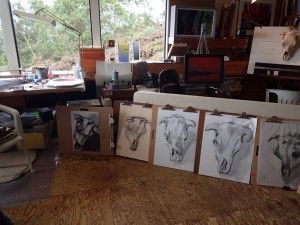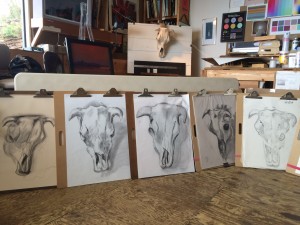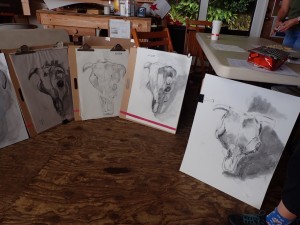The third session of the Advanced Drawing and Composition class for Winter 2016 was held on Wednesday, January 27. We spent time reviewing the corrected images from last week’s assignment, with more questions about light and shadow angles; visualizing the whole shape even when it is not visible from our vantage point; and fine-tuning your rendering technique to achieve the suggestion of form through gray values (Valérie’s many useful videos cover these topics). The last portion of our class time was spent drawing a cow skull from observation with our new medium, charcoal. Read on for more …
Homework assignment
[gview file=”https://dicknelsoncolor.com/wp-content/uploads/2016/01/DrawCompAssign2v2.pdf”]
Class recap – some key ideas
Critique of last week’s corrections and new drawings
We began class by going over the drawings the class brought in this week, some of which were brand new, others that had been corrected and refined from last week’s critique. Overall, the drawings showed an understanding of light and shadow, and especially how the shadow values have to stay consistent in order to unite the image visually. Dick was also pleased with students’ attempts at rendering the geometric forms, taking the time to blend the pencil strokes into wide swaths of similar value without using line work to dictate the edges.
“Now we’re getting somewhere in terms of the kind of gradation I am looking for. When we get into sketching, you may want to see the pencil strokes, and on this one … this is really good rendering. You see here, unlike an outline, it’s just this grey versus this grey that defines that edge, that’s beautiful. And this is the kind of subtlety – you know, until you came in dark here, this may not have worked.”
There were still a few concepts that have proven hard to understand, one being how to find the correct starting point for the hidden side of a cylinder’s shadow. Dick led us through another demo showing how we plot the critical “corners” of a cylindrical shape to find shadow lines.
Drawings Critique 1 (23:02)
Another interesting question that came up was do you get a double shadow when two objects’ shadows overlap? Only if there is more than one light source! Once again, artificial lighting can provide us with conflicting evidence, so the best way to check this is with natural light. In daylight, two overlapping shadows will create only one shadow together, without a change in value. (See the images from last week’s demonstration with the geometric forms outside).
Other issues were briefly addressed (see more critique videos at the bottom of this post), but Dick stressed that there are gains to be made by simply observing nature, and by trying these assignments again and again. If you don’t understand something, work at it until you do. Dick has often mentioned that true learning only takes place when there is a bit of a struggle involved, and once you have gone through a struggle to understand something, the gains cannot be taken from you. Understanding these concepts will inform your artwork and reduce the chance of creating visual errors.
“This is not everyone’s cup of tea … most people say, “I want to be creative”, and this [formal or mechanical drawing] is not creative. But can you imagine being a creative pianist without knowing composition, or how notes go together or words go together in a sentence … All I’m saying is that this is the most basic communication, drawing. If I can draw something that other people can see, they can be Russian, German, Japanese, whatever nationality, but they’ll understand it.”
Paper clip drawings
We moved on to the various paper clip drawings, with Dick discussing again the importance of understanding correct perspective and foreshortening in order to draw this complex object accurately.
Paper Clip (9:00)
Index card challenge
We also had another entry in the index card challenge: Leonard had drawn a square as a puzzle, which was broken up and waiting to be fit together. Amazing to witness that there are still more ways to fulfill that assignment than we have already seen!
Leonard’s Square (2:21)
Charcoal drawing
The charcoal drawing subject
We spent the other half of our class time involved with drawing a cow skull from observation, and using our charcoal for the first time. Dick gave no instructions, just asked everyone to find a spot and go to it. He reminded us to use what we have learned so far, including finding basic geometric shapes within our complex object; using value to create a sense of form and volume; and using light and shadow to give depth and drama to our drawing.
After about an hour of drawing time, we gathered together as a group and looked over the various sketches. This is one of the most complex objects we have drawn to date, and drawing from observation has its unique challenges. Dick critiqued our beginning efforts and gave valuable feedback for how to use this medium to its best advantage.
The charcoal drawings after about an hour of work
- Student’s charcoal drawings
